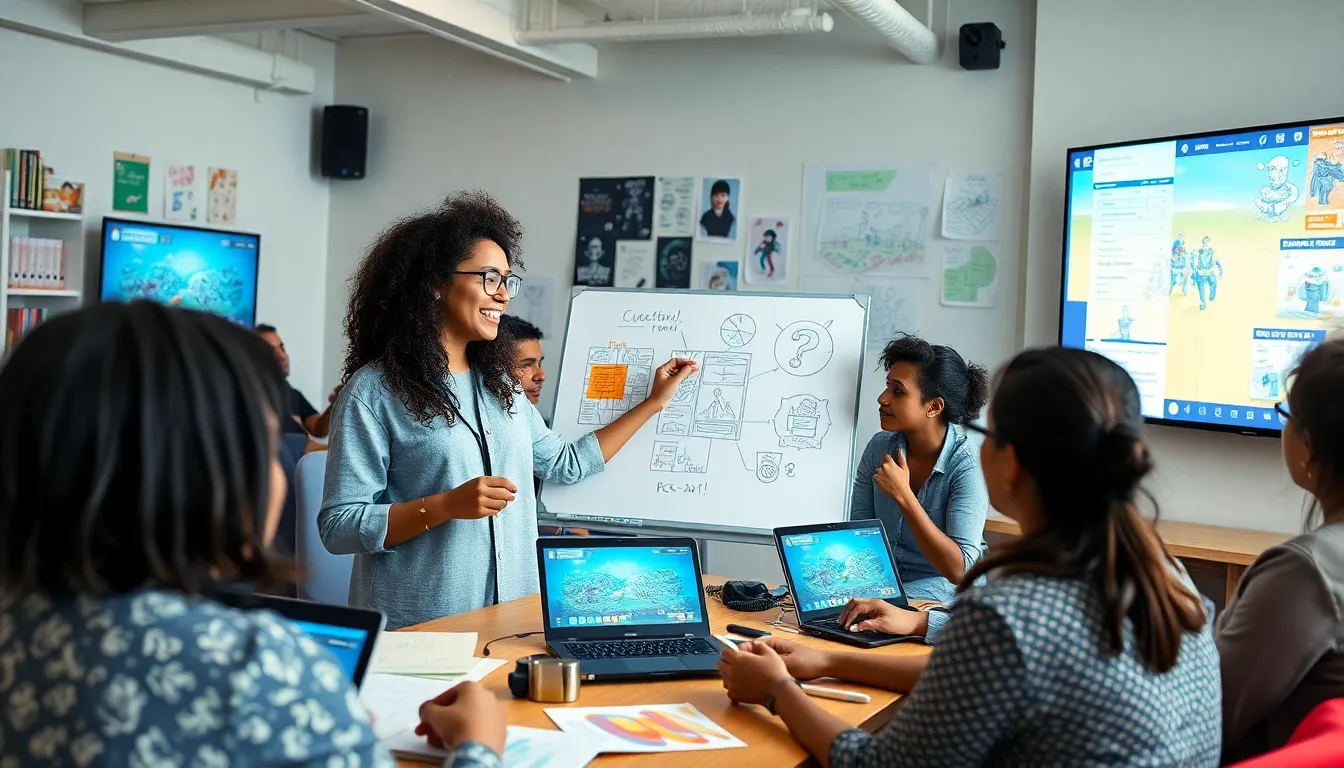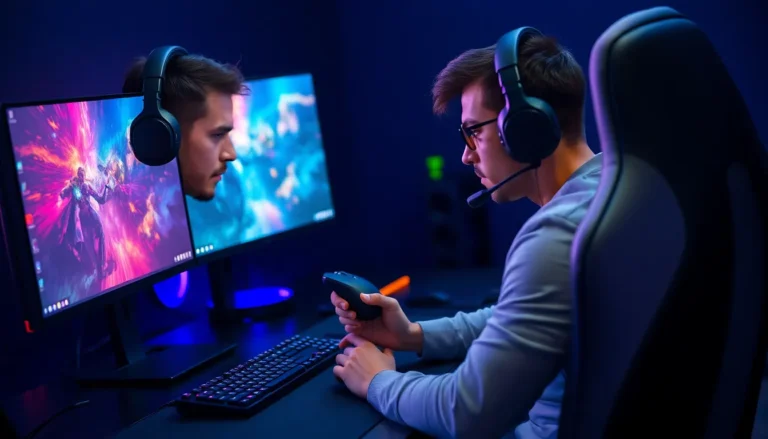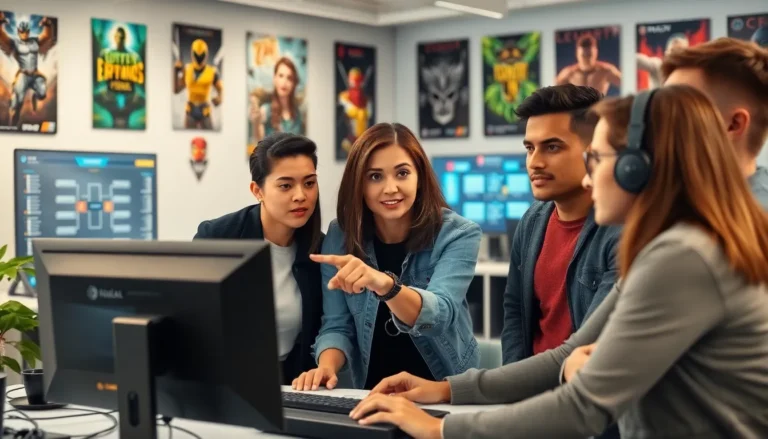In the fast-paced world of game development, prototyping stands as a crucial step that can make or break a project. It allows developers to bring their creative visions to life, testing ideas and mechanics before committing to full-scale production. By creating a prototype, teams can explore gameplay concepts, gather feedback, and refine their designs, ensuring a more polished final product.
Game prototyping isn’t just about building a playable version of a game; it’s about fostering innovation and collaboration. Whether it’s a simple paper prototype or a more complex digital model, the goal is to visualize ideas quickly and efficiently. This iterative process not only saves time and resources but also enhances the overall quality of the game, paving the way for a successful launch. Understanding the importance of prototyping can transform how developers approach their projects, leading to more engaging and enjoyable gaming experiences.
Table of Contents
ToggleOverview of Game Prototyping
Game prototyping serves as a crucial aspect of game development, enabling developers to visualize concepts and mechanics before production. This process fosters creativity and enhances project feasibility.
Definition of Game Prototyping
Game prototyping refers to the creation of an early model or version of a game to test gameplay concepts and mechanics. Prototypes can range from simple paper sketches to fully interactive digital versions. These models allow teams to explore ideas rapidly, identify potential challenges, and iterate on designs effectively.
Importance in Game Development
Prototyping holds significant importance in game development for various reasons:
- Idea Validation: Prototypes help validate game ideas by allowing developers to see how concepts function in practice.
- Feedback Collection: Gathering feedback from players or testers provides valuable insights that can guide further development.
- Risk Reduction: Testing mechanics early reduces risks associated with technical challenges and gameplay flaws.
- Resource Optimization: Prototyping often saves time and resources by highlighting issues early, ensuring that teams invest effort in viable projects.
- Collaborative Environment: This process encourages collaboration among team members, fostering a culture of creativity and innovation.
In essence, game prototyping enhances the quality and appeal of the final product by refining ideas and minimizing potential issues during development.
Types of Game Prototyping

Developers utilize various types of game prototyping to explore ideas effectively. Each type serves a specific purpose in refining gameplay concepts and mechanics.
Paper Prototyping
Paper prototyping involves creating simple, hand-drawn representations of gameplay elements, such as characters, environments, and interfaces. These sketches allow for quick iterations of design concepts and mechanics. Benefits of paper prototyping include:
- Rapid Feedback: Designers can present concepts to team members or players for immediate reactions.
- Cost-Effective: Minimal resources are required, as it primarily needs paper and pens.
- Ideal for Early Stages: Quickly visualizing mechanics or narratives helps in the initial brainstorming phase.
Digital Prototyping
Digital prototyping utilizes software tools to create interactive simulations of game mechanics and elements. This method encompasses a range of fidelity, from low-fidelity wireframes to high-fidelity interactive demos. Advantages of digital prototyping include:
- Interactivity: Users can engage with a prototype as they would with the final product, enhancing feedback quality.
- Visual Detail: Digital prototypes present polished visuals that help stakeholders understand the game’s look and feel.
- Technical Feasibility: Developers assess programming challenges and performance aspects early in the development process.
Choosing between paper and digital prototyping depends on project needs, resource availability, and the specific goals of the prototyping phase.
Tools for Game Prototyping
Various tools facilitate efficient game prototyping, encompassing both software solutions and hardware considerations.
Software Options
An array of software options exists for game prototyping, each serving unique purposes. Notable tools include:
- Unity: This widely-used game engine supports 2D and 3D development, providing robust features for interactive prototyping. Unity accommodates rapid iterations and extensive asset libraries.
- Unreal Engine: Renowned for high-quality graphics, Unreal Engine offers tools for creating visually stunning prototypes. Its Blueprint visual scripting system enables non-programmers to prototype gameplay mechanics efficiently.
- GameMaker Studio: This platform specializes in 2D game development, allowing users to create prototypes using a simple drag-and-drop interface. GameMaker’s scripting language enhances functionality for advanced users.
- Construct: Ideal for beginners, Construct simplifies game creation with a visual interface. It promotes rapid prototyping by enabling users to build games without extensive coding knowledge.
- Figma: While primarily a design tool, Figma enables teams to create interactive user interfaces and animations, streamlining the prototyping of game menus and HUDs.
Hardware Considerations
Hardware considerations play a crucial role in effective game prototyping. Key aspects include:
- Development Workstations: High-performance computers equipped with powerful CPUs and GPUs enhance the ability to run resource-intensive game engines and design software, ensuring smooth workflow and efficient testing.
- Input Devices: Game controllers, VR headsets, and touchscreens allow developers to test user interactions across various platforms. These devices help ensure prototypes meet usability standards and enhance user experiences.
- Prototyping Kits: Physical prototyping kits, such as Arduino or Raspberry Pi, facilitate the development of hybrid games combining hardware and software elements. These kits enable experimentation with gameplay mechanics in new ways.
- Testing Equipment: Quality assurance requires devices to test performance across various hardware configurations. Access to different consoles and mobile devices ensures comprehensive testing during the prototyping phase.
Best Practices for Effective Prototyping
Effective prototyping requires a structured approach to maximize innovation and efficiency. Following specific best practices ensures prototypes enhance the game development process.
Iterative Design Process
An iterative design process emphasizes continuous improvement. Developers should create multiple iterations of a prototype, allowing them to refine gameplay mechanics. Beginning with low-fidelity prototypes, he or she can gradually transform them into high-fidelity versions based on input and testing results. Incorporating frequent testing sessions provides insights into player experiences and identifies areas needing adjustment, which leads to a more polished final product.
Gathering Feedback
Gathering feedback is crucial for validating concepts during the prototyping phase. Involving team members and playtesters early helps identify strengths and weaknesses. He or she should employ surveys, interviews, and observation techniques to collect diverse perspectives. Analyzing this data allows developers to make informed decisions, ensuring the game aligns with player preferences. Continuous feedback loops facilitate an ongoing dialogue between designers and stakeholders, enhancing overall project quality.
Challenges in Game Prototyping
Game prototyping presents several challenges that developers must navigate to achieve success. Understanding these obstacles allows teams to devise effective strategies for overcoming them.
Resource Allocation
Resource allocation poses a significant challenge in game prototyping. Ensuring adequate budget, time, and personnel for the prototyping phase can be difficult. Developing prototypes requires financial investment in software tools, hardware resources, and skilled team members. For example, a project may necessitate hiring additional designers and programmers for a short period, leading to budget constraints. Additionally, time management becomes crucial, as teams must balance prototyping with other development phases. Effective prioritization of tasks and careful planning directly impacts a project’s overall success and efficiency.
Balancing Innovation and Feasibility
Balancing innovation and feasibility serves as another challenge in game prototyping. Developers seek to create groundbreaking concepts while remaining within technical and budgetary limitations. Innovative ideas often require advanced technology or unique gameplay elements that might not be feasible with available resources. For instance, designing a complex physics engine might excite a team but could exceed project timelines and budgets. Establishing a clear vision that aligns innovative concepts with achievable goals fosters pragmatic decision-making. Regular evaluations of design decisions ensure teams maintain focus on high-impact innovations without compromising project feasibility.
Game prototyping stands as a cornerstone of successful game development. By embracing this iterative process developers can refine their ideas and enhance gameplay experiences. The choice between paper and digital prototypes allows teams to explore concepts effectively while leveraging the right tools ensures a streamlined development journey.
Effective prototyping not only mitigates risks but also fosters innovation and collaboration. By gathering feedback early and often developers can make informed decisions that lead to a more polished final product. Overcoming challenges in resource allocation and balancing creativity with feasibility ultimately paves the way for engaging and memorable gaming experiences. Embracing the prototyping phase is essential for any developer aiming to create impactful games.





